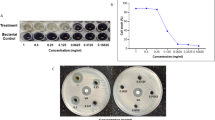Abstract
Anti-inflammatory, analgesic, and leukocyte mobilization activities of ciprofloxacin, lincomycin, and erythromycin were evaluated in this study. The study involved two sets of thirty-three adult female Wistar rats assigned into five treatments, grouped into eleven of three rats per group. For agar-induced paw edema, the first three groups were treated 10 mg/kg, 20 mg/kg, and 40 mg/kg of ciprofloxacin, next three groups same doses of lincomycin, next three groups same doses of erythromycin, the tenth group received the reference drug, indomethacin 5 mg/kg while the last group 5 mg/kg normal saline. The analgesic activities group treatments were first nine groups received the three antibiotics in the same trend but at different doses of 50 mg/kg, 100 mg/kg, and 200 mg/kg. The tenth group received acetylsalicylic acid (Asp 100 mg/kg) while the last group received normal saline (5 ml/kg). Erythromycin had minimal effect on rat paw edema with non-significant inhibition. Ciprofloxacin and lincomycin suppressed agar-induced rat paw edema both at early and later phases of edema. Remarkably, lincomycin was most effective. Whereas lincomycin suppressed the action of phospholipase A2 with increasing concentration, erythromycin and ciprofloxacin best inhibited the enzyme at their lowest concentrations. Whereas ciprofloxacin had an analgesic effect, lincomycin and erythromycin did not exhibit analgesic effects. The three antibiotics significantly reduced leucocyte mobilization into the affected tissue especially at the highest dose (40 mg kg−1). Conclusively, based on our findings, we suggest that these antibiotics can be considered for use as anti-inflammatory and analgesic drugs. The testing drugs prevented leukocyte mobilization.
Similar content being viewed by others
References
Bhattacherjee P, Williams RN, Eakins KE (1983) A comparison of the ocular anti- inflammatory activity of steroidal and non-steroidal compounds in the rat. Investig Ophthalmol Vis Sci 24:1143–1146
Dale DC, Boxer L, Liles CW (2008) The phagocytes: neutrophils and monocytes. Blood 112:935–945
Derrell C (1996) Guide for the care and use of laboratory animals. Institute of Laboratory Animal Resources. National Academy Press, Washington DC
Dray A (1995) Inflammatory mediators of pain. Br J Anaesth 75:125–131
Ferrero-Miliani L, Nielsen OH, Andersen PS, Girardin SE (2007) Chronic inflammation: importance of NOD2 and NALP3 in interleukin-1beta generation. Clin Exp Immunol 147(2):06–11
Foegh ML, Ramwell PW (2001) The eicosanoids: prostaglandins, thromboxanes, leukotrienes and related compounds. In (Kartzung, B. G. ed.). Basic and clinical pharmacology.8th edition. Lange Medical Books/McGraw-Hill, NewnYork. pp 311–325
Gebhart GF, McCormack KJ (1994) Neuronal plasticity; implications for pain therapy. Drugs 47(5):1–47
Hoff J (2000) Methods of blood collection in the mouse. Lab Anim 29(10):50–51
Janssen PAJ, Jagenea AH (1957) A new series of potent analgesics: dextro 2,2-diphenyl- methyl- H-morholino-butryprolidine and related amides. Part 1. Chemical structure and pharmacological activity. Aust J Pharm 9:38
Kang HS, Lee JY, Kim CJ (2008) Anti-inflammatory activity of arctigenin from Forsythiae fructus. J Ethnopharmacol 116:305–310
Konttiene YT, Kemppinen P, Segerberg M, Hukkanen M, Rees R, Santavirta S, Sorsa T, Pertovaara A, Polak JM (1994) Peripheral and spinal neural mechanisms in arthritis with particular reference to treatment of inflammation and pain. Arthritis Rheum 37:965–982
Morimoto R, Locker J, Synenki RM, Rabinowitz M (1979) Transcription, processing, and mapping of mitochondrial RNA from grande and petite yeast. J Biol Chem 254:12461–12470
Parkhouse J, Pleuvry BJ (1979) Analgesic drugs. Blackwell Co., Oxford, p 1
Ribeiro RA, Flores CA, Cunha FQ, Ferreira SH (1991) IL-8 causes in vivo neutrophil migration by a cell dependent mechanism. Immunology 73:472–477
Roberts JL, Morrow JD (2001) Analgesic-antipyretic and anti-inflammatory agents and drugs employed in the treatment of gout In: (eds Gilman AG, Hardman JG, Limbird LE) 10th Edn. Goodnam and Gilmans the pharmacological basis of therapeutics. McGraw Hill Co., New York pp.687-731
Sharma KK, Khanna T, Sen P (1982) Current status of centrally acting peptides. In: (Dhawan, BN, ed) Advances in biosciences Vol 38, Oxford: Pergamon Press pp.147
Sárközy G (2001) Quinolones: a class of antimicrobial agents. Veterinary Medi Czech 46(9–10):257–274
Schimmer BP, Parker KL (2001) Adrenocorticotrophic hormone; adrenocortical steroids and their synthetic analogues; inhibitors of the synthesis and actions of adrenocortical hormones In: (Gilman AG, Hardman JG, Limbird LE. Eds) 10th Ed. Goodman and Gilman’s the pharmacological basis of therapeutics. McGraw Hill Co., New York. 2001 pp.1649–1677
Tenson T, Lovmar M, Ehrenberg M (2003) The mechanism of action of macrolides, lincosamides and streptogramin B reveals the nascent peptide exit path in the ribosome. J Molecular Bio 330(5):1005–1014
Vega MA, Corbi AL (2006) Human macrophage activation: too many functions and phenotypes for a single cell type. Immunologia 25:248–272
Vane JR (1971) Inhibition of prostaglandin synthesis as a mechanism of action for aspirin-like drugs. Nat New Biol 231:232–235
Wallace JM (2002) Nutritional and botanical modulation of the inflammatory cascade: eicosanoids, cxyclooxgenase and lipooxygenase-as an adjunct in cancer therapy. Integr Cancer Ther 1:7–37
Winter CA, Risley EA, Nuss GW (1962) Carrageenan-induced oedema in the hind paw of rat as an assay for anti-inflammatory activity. ProcSoc Exp Biol Ther 111:544–547
Yankanchi SR, Koli SA (2010) Anti-inflammatory and analgesic activity of mature leaves and methanol extract of Clerodendrum inerme L. (Gaertn). J Pharmaceu Sci Res 11(2):782–785
Author information
Authors and Affiliations
Corresponding author
Ethics declarations
Conflict of interest
The authors declare that they have no conflict of interest.
Ethical approval
Handling of experimental animals used in this research was in accordance with that recommended by the Committee and the International Guidelines for Handling of Laboratory Animals (Derrell 1996).
Informed consent
Informed consent was obtained from each participant included in the study.
Additional information
Publisher’s note
Springer Nature remains neutral with regard to jurisdictional claims in published maps and institutional affiliations.
Rights and permissions
About this article
Cite this article
Chukwunelo, A.C., Anosike, A.C., Nwodo, O.F.C. et al. Evaluation of anti-inflammatory and analgesic activities of selected antibiotics in Wistar Albino rats. Comp Clin Pathol 28, 1717–1727 (2019). https://doi.org/10.1007/s00580-019-03013-x
Received:
Accepted:
Published:
Issue Date:
DOI: https://doi.org/10.1007/s00580-019-03013-x




